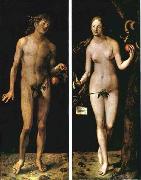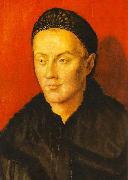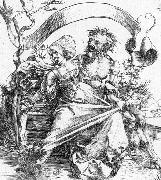All Albrecht Durer Oil Paintingsb.May 21, 1471, Imperial Free City of N??rnberg [Germany] d.April 6, 1528, N??rnberg |
|||
 |
|||
|
|
|
||||||||||
|
|
||||||||||
|
Adam and Eve Gemälde IDENTIFIZIERUNG:: 58705 |
Adam and Eve Adam and Eve, by Albrecht D??rer (1507). Adam and Eve, by Albrecht D??rer (1507). |
|||||||||
|
|
||||||||||
|
|
Portrait of a Man Gemälde IDENTIFIZIERUNG:: 63545 |
Portrait of a Man 1504 Oil on panel, 43 x 29 cm Museum of Fine Arts, Budapest D?rer's paintings include altarpieces, religious pictures and some outstanding portraits. Although he began by working in the German late Gothic tradition, D?rer was to introduce the Renaissance to Germany with his pure compositions in which the sure touch of the draughtsman is always evident. With his workshop and followers he marked out the lines of development of the new style for later years. This small picture - a portrait of a youth, painted in brilliant, warm colours - is sometimes ascribed to D?rer's pupils (Hans S?ss von Kulmbach or Hans Baldung Grien). Some scholars believe to recognize in the sitter D?rer's brother Andreas; however the smooth features and simple attire hardly provide enough clues for identifying the sitter. However, a silverpoint drawing by D?rer in the Albertina Collection in Vienna shows the same model in a similar pose, clearly indicated in the inscription as Endres D?rer, the painter's younger brother 1504 Oil on panel, 43 x 29 cm Museum of Fine Arts, Budapest D?rer's paintings include altarpieces, religious pictures and some outstanding portraits. Although he began by working in the German late Gothic tradition, D?rer was to introduce the Renaissance to Germany with his pure compositions in which the sure touch of the draughtsman is always evident. With his workshop and followers he marked out the lines of development of the new style for later years. This small picture - a portrait of a youth, painted in brilliant, warm colours - is sometimes ascribed to D?rer's pupils (Hans S?ss von Kulmbach or Hans Baldung Grien). Some scholars believe to recognize in the sitter D?rer's brother Andreas; however the smooth features and simple attire hardly provide enough clues for identifying the sitter. However, a silverpoint drawing by D?rer in the Albertina Collection in Vienna shows the same model in a similar pose, clearly indicated in the inscription as Endres D?rer, the painter's younger brother |
||||||||
|
|
||||||||||
|
|
The Great Courier Gemälde IDENTIFIZIERUNG:: 63562 |
The Great Courier 1495 Engraving, 100 x 113 mm Kupferstichkabinett, Dresden Earlier doubts have given way to the opinion that this is D?rer's first experimental engraving since a drawing was found at Danzig (presently Gdansk in Poland) which apparently served as the model for this subject. This drawing is inscribed by D?rer: This was drawn by Wolfgang Peuer in the year 1484. Nothing else is known about Peuer. He may have been an apprentice or an assistant in the goldsmith's shop of D?rer the Elder or in the workshop of D?rer's teacher, the painter Michael Wolgemut. The watermark of the paper used for the printing of this engraving, "Cardinals's Hat," was used by D?rer infrequently beginning in 1507. It was also used for the posthumous edition of D?rer's book Unterweisung der Messung (Instructions on measurement). The rarity of this print, as well as the watermark, suggests that the remaining impressions (Dresden, Melbourne, Paris aand Vienna) are posthumous.Artist:D?RER, Albrecht Title: The Great Courier Painted in 1501-1550 , German - - graphics : other 1495 Engraving, 100 x 113 mm Kupferstichkabinett, Dresden Earlier doubts have given way to the opinion that this is D?rer's first experimental engraving since a drawing was found at Danzig (presently Gdansk in Poland) which apparently served as the model for this subject. This drawing is inscribed by D?rer: This was drawn by Wolfgang Peuer in the year 1484. Nothing else is known about Peuer. He may have been an apprentice or an assistant in the goldsmith's shop of D?rer the Elder or in the workshop of D?rer's teacher, the painter Michael Wolgemut. The watermark of the paper used for the printing of this engraving, "Cardinals's Hat," was used by D?rer infrequently beginning in 1507. It was also used for the posthumous edition of D?rer's book Unterweisung der Messung (Instructions on measurement). The rarity of this print, as well as the watermark, suggests that the remaining impressions (Dresden, Melbourne, Paris aand Vienna) are posthumous.Artist:D?RER, Albrecht Title: The Great Courier Painted in 1501-1550 , German - - graphics : other |
||||||||
|
|
||||||||||
|
|
Young Woman Attacked by Death Gemälde IDENTIFIZIERUNG:: 63563 |
Young Woman Attacked by Death 1494 Engraving, 114 x 102 mm Staatliche Kunsthalle, Karlsruhe In the middle of the picture, on a turf bench, a wild wood gnome is attacking a young woman who defends herself angrily. While the lean, bony man is reminiscent of depictions of Death, the dead tree to the left of the turf bench is a symbol of vice and fated undoing. The original intention was to include a commentary, as is shown by the empty inscription cartouche above the scene. The most obvious interpretation is that made by Panofsky, who considered the small genre picture to be an allegory of death. This engraving is today generally accepted as being by D?rer, although it is reminiscent of the Housebook master in several respects. The thistle-like plant in the background, eryngium (sea holly), occurs in several of D?rer's early works. Its reputedly aphrodisiac qualities were, according to Pliny, known already to the ancient Greeks, and apparently fascinated the young D?rer. Perhaps the print is related to a Nuremberg news item of the year 1489, when a man was hanged for a number of attacks on women.Artist:D?RER, Albrecht Title: Young Woman Attacked by Death; or, The Ravisher Painted in 1501-1550 , German - - graphics : mythological 1494 Engraving, 114 x 102 mm Staatliche Kunsthalle, Karlsruhe In the middle of the picture, on a turf bench, a wild wood gnome is attacking a young woman who defends herself angrily. While the lean, bony man is reminiscent of depictions of Death, the dead tree to the left of the turf bench is a symbol of vice and fated undoing. The original intention was to include a commentary, as is shown by the empty inscription cartouche above the scene. The most obvious interpretation is that made by Panofsky, who considered the small genre picture to be an allegory of death. This engraving is today generally accepted as being by D?rer, although it is reminiscent of the Housebook master in several respects. The thistle-like plant in the background, eryngium (sea holly), occurs in several of D?rer's early works. Its reputedly aphrodisiac qualities were, according to Pliny, known already to the ancient Greeks, and apparently fascinated the young D?rer. Perhaps the print is related to a Nuremberg news item of the year 1489, when a man was hanged for a number of attacks on women.Artist:D?RER, Albrecht Title: Young Woman Attacked by Death; or, The Ravisher Painted in 1501-1550 , German - - graphics : mythological |
||||||||
|
|
||||||||||
| VORHERIGER KÜNSTLER NÄCHSTER KÜNSTLER | ||||||||||
|
|
||||||||||
| Albrecht Durer | ||||||||||
| b.May 21, 1471, Imperial Free City of N??rnberg [Germany] d.April 6, 1528, N??rnberg | ||||||||||
|
|
||||||||||
|
KONTAKTIEREN Sie UNS |









